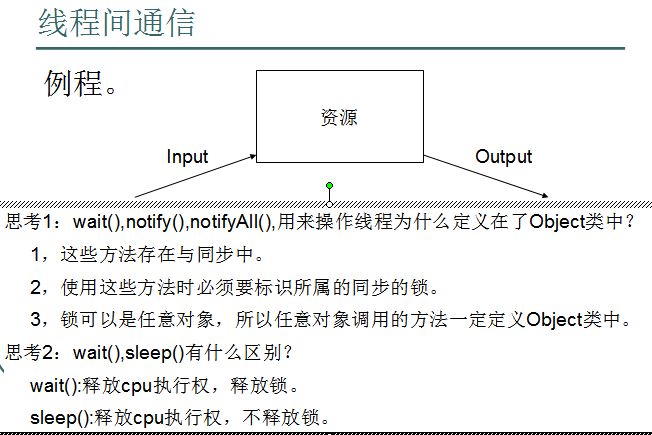------- android培训、java培训、期待与您交流! ----------

/*
线程间通讯:
其实就是多个线程在操作同一个资源。
但是操作的动作不同。
*/
class Res
{
String name;
String sex;
boolean flag = false;
}
class Input implements Runnable
{
private Res r;
Input(Res r)
{
this.r = r;
}
public void run()
{
int x = 0;
while(true)
{
synchronized(r)
{
if(r.flag)
try{r.wait();}catch(Exception e){}
if(x == 0)
{
r.name = "mike";
r.sex = "man";
}
else
{
r.name = "丽丽";
r.sex = "女";
}
x=(x+1)%2;
r.flag = true;
r.notify();
}
}
}
}
class Output implements Runnable
{
private Res r;
Output(Res r)
{
this.r = r;
}
public void run()
{
while(true)
{
synchronized(r)
{
if(!r.flag)
try{r.wait();} catch(Exception e){}
System.out.println(r.name+"..."+r.sex);
r.flag = false;
r.notify();
}
}
}
}
class InputOutput
{
public static void main(String[] args)
{
Res r = new Res();
new Thread(new Input(r)).start();
new Thread(new Output(r)).start();
}
}
----------------------------------------------------------------------------------------------------------------------------------------------------------------------------------------------------------------------------
/*
线程间通讯:
其实就是多个线程在操作同一个资源。
但是操作的动作不同。
优化代码:
*/
class Res
{
private String name;
private String sex;
private boolean flag = false;
public synchronized void set(String name,String sex)
{
if(flag)
try{this.wait();}catch(Exception e){}
this.name = name;
this.sex = sex;
flag = true;
this.notify();
}
public synchronized void out()
{
if(!flag)
try{this.wait();}catch(Exception e){}
System.out.println(name+"..."+sex);
flag = false;
this.notify();
}
}
class Input implements Runnable
{
Object obj = new Object();
private Res r;
Input(Res r)
{
this.r = r;
}
public void run()
{
int x = 0;
while(true)
{
if(x==0)
r.set("mike","man");
else
r.set("丽丽","女");
x = (x+1)%2;
}
}
}
class Output implements Runnable
{
Object obj = new Object();
private Res r;
Output(Res r)
{
this.r = r;
}
public void run()
{
while(true)
{
r.out();
}
}
}
class InputOutputDemo
{
public static void main(String[] args)
{
Res r = new Res();
new Thread(new Input(r)).start();
new Thread(new Output(r)).start();
}
}
/*
wait;
notify();
notifyAll();
都使用在同步中,因为要对持有监视器(锁)的线程操作。
所以要使用在同步中,因为只有同步才具有锁。
为什么这些操作线程的方法要定义Objetc类中呢?
因为这些方法在操作同步中线程时,都必须要标识他们
所操作线程持有的锁,只有同一个锁上的被等待线程,
可以被同一个锁上notify唤醒。不可以对不同锁中的
线程进行唤醒。
也就是说,等待和唤醒必须是同一个锁。
而锁可以是任意对象,所以可以被任意对象调用的方法
定义在Object类中。
*/
------------------------------------------------------------------------------------------------------------------------------------------------------------------------------------------------------------------------------
/*
生产者和消费者
对于多个生产者和消费者。
为什么要定义while判断标记。
原因:让被唤醒的线程再一次判处标记。
为什么定义notifyAll,
因为需要唤醒对方线程。
因为只用notify,容易出现只唤醒本方线程的情况,导致
程序中的所有线程都等待。
*/
class ProducerConsumerDemo
{
public static void main(String[] args)
{
Resource r = new Resource();
Producer pro = new Producer(r);
Consumer con = new Consumer(r);
Thread t1 = new Thread(pro);
Thread t2 = new Thread(pro);
Thread t3 = new Thread(con);
Thread t4 = new Thread(con);
t1.start();
t2.start();
t3.start();
t4.start();
}
}
class Resource
{
private String name;
private int count = 1;
private boolean flag = false;
public synchronized void set(String name)
{
while(flag)
try{this.wait();}catch(Exception e){}
this.name = name+"---"+count++;
System.out.println(Thread.currentThread().getName()+"...生产者..."+this.name);
flag = true;
this.notifyAll();
}
public synchronized void out()
{
while(!flag)
try{this.wait();}catch(Exception e){}
System.out.println(Thread.currentThread().getName()+"-----消费者-----"+this.name);
flag = false;
this.notifyAll();
}
}
class Producer implements Runnable
{
private Resource res;
Producer(Resource res)
{
this.res = res;
}
public void run()
{
while(true)
{
res.set("+商品+");
}
}
}
class Consumer implements Runnable
{
private Resource res;
Consumer(Resource res)
{
this.res = res;
}
public void run()
{
while(true)
{
res.out();
}
}
}
-------------------------------------------------------------------------------------------------------------------------------------------------------------------------------------------------------------------------------------
/*
生产者和消费者
JDK1.5版本中提供了多线程了升级解决方案。
将同步synchronized替换成Lock操作
将Object中的wait,notify,notifyAll,替换成Condition对象。
该对象可以通过Lock锁,进行获取。
该示例中,实现了本方只唤醒对方的操作。
*/
import java.util.concurrent.locks.*;
class ProducerConsumerDemo2
{
public static void main(String[] args)
{
Resource r = new Resource();
Producer pro = new Producer(r);
Consumer con = new Consumer(r);
Thread t1 = new Thread(pro);
Thread t2 = new Thread(pro);
Thread t3 = new Thread(con);
Thread t4 = new Thread(con);
t1.start();
t2.start();
t3.start();
t4.start();
}
}
class Resource
{
private String name;
private int count = 1;
private boolean flag = false;
private Lock lock = new ReentrantLock();
private Condition condition_pro = lock.newCondition();
private Condition condition_con = lock.newCondition();
public void set(String name)throws InterruptedException
{
lock.lock();
try
{
while(flag)
condition_pro.await();
this.name = name+"---"+count++;
System.out.println(Thread.currentThread().getName()+"...生产者..."+this.name);
flag = true;
condition_con.signal();//唤醒消费者
}
finally
{
lock.unlock();
}
}
public void out()throws InterruptedException
{
lock.lock();
try
{
while(!flag)
condition_con.await();
System.out.println(Thread.currentThread().getName()+"-----消费者-----"+this.name);
flag = false;
condition_pro.signal();
}
finally
{
lock.unlock();//释放锁的动作一定要执行。
}
}
}
class Producer implements Runnable
{
private Resource res;
Producer(Resource res)
{
this.res = res;
}
public void run()
{
while(true)
{
try
{
res.set("+商品+");
}
catch(InterruptedException e)
{
}
}
}
}
class Consumer implements Runnable
{
private Resource res;
Consumer(Resource res)
{
this.res = res;
}
public void run()
{
while(true)
{
try
{
res.out();
}
catch(InterruptedException e)
{
}
}
}
}----------------------------------------------------------------------------------------------------------------------------------------------------------------------------------------------------------------------
个人总结:
 并发编程与线程间通信
并发编程与线程间通信




 本文详细介绍了并发编程中的线程间通信机制,包括使用synchronized关键字、wait、notify等方法实现同步与异步操作,以及通过Condition对象优化代码。同时,文中还通过生产者与消费者模型和JDK 1.5版本提供的Lock操作进一步阐述了线程间通信的实践应用。
本文详细介绍了并发编程中的线程间通信机制,包括使用synchronized关键字、wait、notify等方法实现同步与异步操作,以及通过Condition对象优化代码。同时,文中还通过生产者与消费者模型和JDK 1.5版本提供的Lock操作进一步阐述了线程间通信的实践应用。

















 被折叠的 条评论
为什么被折叠?
被折叠的 条评论
为什么被折叠?








